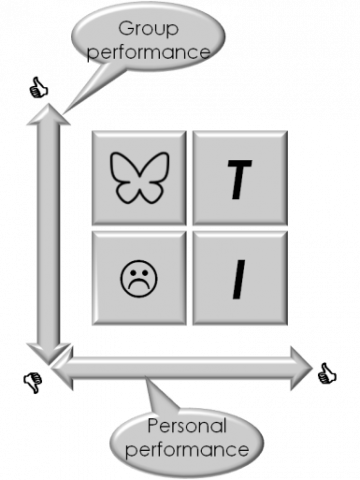In an earlier post I warned for mini-waterfall in disguise, putting ‘cross-functional’ forward as a better term to describe team cooperation than ‘multi-disciplinary’. So how do you recognize cross-functional teams, that are not multi-disciplinary teams in disguise? Well, they are populated by T-shaped professionals.
T-shaped as in tester-shaped? Hmm, not really ;-) T-shaped refers to, well, to the shape of the letter T, where the horizontal top line represents broad experience and the vertical stroke specific expertise. And It bears to how well one performs both individually and as a group member.
Combining these two dimensions result in four possible quadrants:

| ☹ | The bottom left quadrant is a sad one: poor performance either way … |
| The top left one (great group performance, not so great individually) refers to empathic people that are the glue in a group, that ensure a good working spirit but unfortunately have little to none individual contribution to the group’s success. | |
| I | The bottom right one (great personal performance, group wise not so great) is the traditional specialist, very good if not excellent at what he does, but little to no interest or feeling for matters outside his own field of expertise. |
| T | The top right quadrant (great performance all the way) reflects the T-shape individual that combines individual excellence with empathic group behavior. |
So, what makes you a T-shaped individual?
t’s the combination of 4 distinct qualities:
Your T has got a good ‘specialist leg’. This can be programming, design, analysis, testing, … etc.
The bar of your T reflects three competences:
Firstly: broad IT knowledge. If you’re a programmer you also know some design principles, analysis models and test coverage benefits. If you’re a designer, you are familiar with some programming languages, analysis models and testing. If you’re an analyst you would know something about … well, you get the picture, about all those other IT disciplines.
Secondly: subject matter knowledge. When you’re in a team producing banking software, you know banking; when you’re in transportation, you know transportation. You might not be an expert in that specific field, but you talk the talk.
Thirdly, but certainly not lastly, you are empathic, enthusiastic, inquisitive. You can relate to someone else's ideas, you can to see things from a different perspective than merely from your own specialty. You’re a "lifelong learner".
A T-shaped individual is not the new ‘Uomo Universale’ that knows everything about everything, but he does know al lot about a lot!

In the new test method TMap HD five elements are introduced. People is one of them and the basis of the other elements (Industrialize, Integrate, Simplify and Confidence). To apply a Human Driven method like TMap HD, you need this kind of T-shaped individuals.
Take a look in the mirror and be honest to yourself: are you T-shaped? Or do you – like the most of us! – most fit the profile of a specialist or generalist that still needs to make some steps on one or more of the four axes to truly become a T-shaped individual?
Published: 22 May 2015
Author: Ben Visser
|
Ben Visser (*1960 - +2018) Ben was a highly experienced test manager and test consultant. In a career of over 15 years as a tester, he fulfilled a wide range of test functions, from programmer of automated scripts, to test manager of a large international program. We thank him for his work with Sogeti and his contribution to TMap. |

